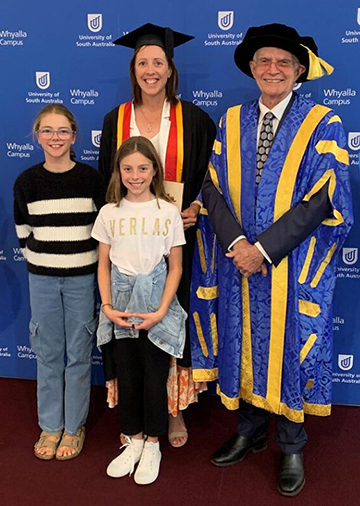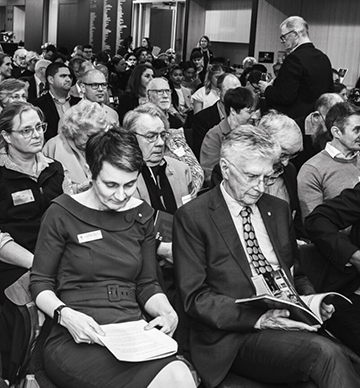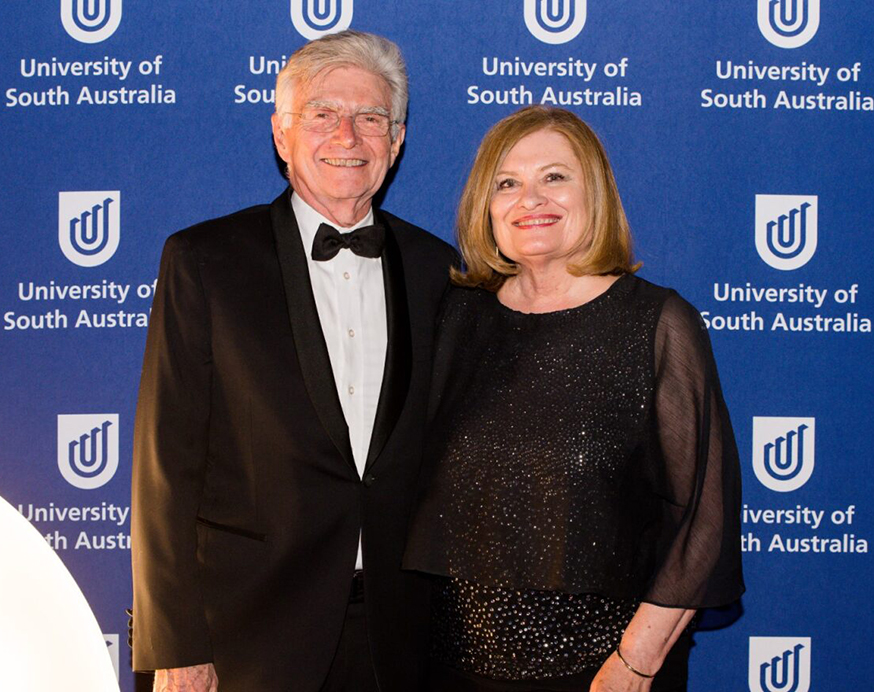17 June 2024

ceremonies last month, pictured with Stacey Franklin
(and family) who graduated from a Grad Dip Urban and Regional Planning
Most people are more familiar with John Hill’s political and business background – including more than a decade of ministerial roles in the South Australian government leading portfolios such as health, arts, and the environment – than his teaching past. UniSA’s new Chancellor shares his experience of stepping up from deputy to the main role.
For John Hill, a devoted grandfather of three and former schoolteacher, sharing the joy of graduations with families was an ideal way to launch his official duties as the new Chancellor of the University of South Australia.
John has shared his experience with UniSA since 2015 when he joined Council as an appointed member, before taking on the role of Deputy Chancellor in 2018. For more than a decade he held South Australian ministerial roles, serving as Minister for Environment and Conservation, Minister for Health, and Minister for the Arts. Since retiring from politics in 2014, he’s also contributed his expertise on a variety of boards, including currently Bellberry Ltd and Private Healthcare Australia.
Mount Gambier’s May graduation event coincided with John’s first day on the job, with Whyalla’s ceremony following close behind. “It was so interesting visiting Mount Gambier and Whyalla, they really looked after me – it felt like a Royal visit!” John says. “I met lots of local people, and it was clear they view the University as an integral part of their community.”
Regional education is close to John’s heart, as part of a broader enthusiasm for more accessible higher education. “There are many people who are more than capable of pursuing higher education, but don’t,” he says. “Everyone who has the capacity and interest for higher education should be able to participate, that choice shouldn’t be determined by post code or any other demographic factor. It’s an issue that’s just as important for the overall Australian economy as it is from a social perspective.”

occasionally assuming the responsibilities of the Chancellor
at events such as one of the 2023 Scholarships and Grants Ceremonies.
Ensuring education is inclusive and accessible is one of UniSA’s key values, and one that will carry through into the new Adelaide University.
As work on the transition to the new institution ramps up, it’s certainly an interesting time to be the Chancellor of UniSA. With 19 months left before the University’s next evolution, John sees his role – and that of the wider University team – as comprising two key jobs. “First, we need to make sure the business of the University is carried out as well it can be, we don’t take the foot off the pedal, right up to the very moment of transition. We want to ensure experiences and outcomes for our students and our staff continue to be excellent.
“And second, we need to do everything needed to create the new Adelaide University – both under our Tripartite Agreement, as well as everything we morally can to support our people during this process. It’s important that as a team, we don’t do things that are not necessary while working in this duality. To the extent that I can simplify the machinery, I will.”
John says UniSA’s remarkable accomplishments must be properly celebrated during the transition period. He says these achievements were made possible through the work of great people, including the strong intellectual and moral leadership of successive Vice Chancellors and the leaders they recruited, and this should be recognised. He also praises the work of his predecessor, Pauline Carr, who is now Chancellor of the Adelaide University Transition Council.
“From academic transformation, to pandemic, to a new university, Pauline led us with a calm head and strong heart. I know she will deliver the same excellent governance at Adelaide University.”
He emphasises that institutional change does not mean the University’s people and its values are changing. “They will continue, just as our current culture reflects that of our antecedent institutions. This sense of continuity is to be celebrated. We will begin our next chapter with a bang – not a whimper!”
So what does John find most inspiring about the institution “in progress”?
“At the top for me would be the creation of contemporary curriculum for new generations of learners. To be able to draw on the strengths and legacies of two world-leading institutions to design programs and courses that deliver global best practice is something very special.”

Fun facts…
- John was born in Sydney, where he completed an arts degree. He hitchhiked to Adelaide after graduating and has remained there since.
- Despite his father’s insistence he wouldn’t get a job because of his long hair, he soon took up a position as a high school teacher with the Department of Education, teaching English.
- John was drawn to the teachers’ union and became somewhat of an activist, which ignited a passion for politics. This led to a suite of advisory roles, initially with the Minister for Education. He completed a law degree at the University of Adelaide during these years (which he had started and abandoned in Sydney).
- John has long been a fitness enthusiast and he’s not slowing down. Two years ago, he took up running and can now clock up 12 kilometres. His current focus is on speed, as he prepares to run the City to Bay with one of his sons.
- John and his wife are keen gardeners and enjoy growing fruit and vegetables in their back yard.
- Despite his English teaching roots, John says he’s neglected reading and is making up for it now, managing an impressive 150 books last year. It’s not surprising he takes a strategic, structured approach. He started with the Miles Franklin and Booker Prize winners then headed into 19th Century classics. Now he’s onto philosophy and Shakespeare.




